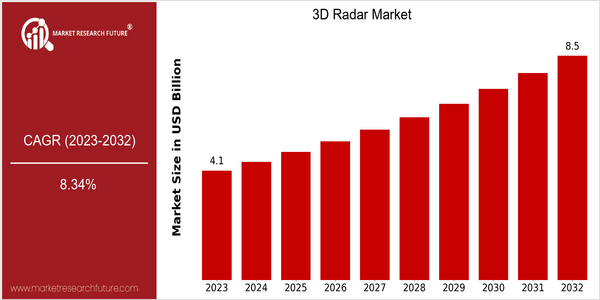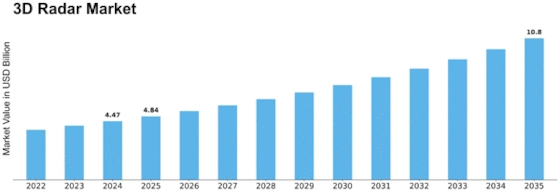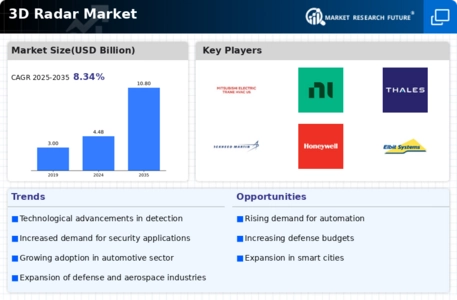3d Radar Size
Market Size Snapshot
| Year | Value |
|---|---|
| 2023 | USD 4.13 Billion |
| 2032 | USD 8.5 Billion |
| CAGR (2024-2032) | 8.34 % |
Note – Market size depicts the revenue generated over the financial year
The 3D Radar market is currently valued at USD 4.13 billion in 2023 and is projected to reach USD 8.5 billion by 2032, reflecting a robust compound annual growth rate (CAGR) of 8.34% from 2024 to 2032. This growth trajectory indicates a strong demand for advanced radar technologies across various sectors, including defense, automotive, and aerospace, driven by the increasing need for enhanced surveillance, navigation, and object detection capabilities. As industries continue to embrace automation and smart technologies, the adoption of 3D radar systems is expected to accelerate, further propelling market expansion.
Key factors contributing to this growth include advancements in radar technology, such as the integration of artificial intelligence and machine learning, which enhance the accuracy and efficiency of 3D radar systems. Additionally, the rising investments in defense and security infrastructure globally are fostering a favorable environment for market players. Notable companies in the 3D radar space, such as Northrop Grumman, Raytheon Technologies, and Thales Group, are actively pursuing strategic initiatives, including partnerships and product innovations, to strengthen their market position and meet the evolving demands of their customers.

Regional Market Size
Regional Deep Dive
The 3D Radar Market is experiencing significant growth across various regions, driven by advancements in radar technology and increasing demand for enhanced surveillance and monitoring systems. In North America, the market is characterized by a strong presence of key players and substantial investments in defense and security applications. Europe is witnessing a surge in the adoption of 3D radar systems for automotive and aerospace applications, while the Asia-Pacific region is rapidly expanding due to increasing urbanization and infrastructure development. The Middle East and Africa are focusing on defense modernization, and Latin America is gradually embracing 3D radar technology for various applications, including environmental monitoring.
Europe
- The European Union has initiated several projects aimed at integrating 3D radar technology into smart transportation systems, with companies like Thales Group playing a pivotal role.
- Regulatory changes in the automotive sector, particularly in the UK and Germany, are pushing for the adoption of advanced driver-assistance systems (ADAS) that utilize 3D radar technology.
Asia Pacific
- China's rapid urbanization has led to increased investments in smart city projects, where 3D radar systems are being deployed for traffic management and public safety.
- India's defense sector is seeing a rise in demand for 3D radar systems, with the government promoting indigenous manufacturing through initiatives like 'Make in India'.
Latin America
- Brazil is exploring the use of 3D radar technology for environmental monitoring and disaster management, supported by government programs aimed at sustainability.
- Argentina is beginning to adopt 3D radar systems for agricultural applications, enhancing precision farming techniques and crop monitoring.
North America
- The U.S. Department of Defense has been actively investing in 3D radar systems to enhance national security, leading to collaborations with companies like Raytheon and Northrop Grumman.
- Recent innovations in solid-state radar technology have been pioneered by companies such as L3Harris Technologies, which are expected to improve the accuracy and reliability of 3D radar systems.
Middle East And Africa
- Countries in the Gulf Cooperation Council (GCC) are investing heavily in defense capabilities, with 3D radar systems being a key focus area for modernization efforts.
- The UAE has launched several initiatives to enhance border security using advanced 3D radar technologies, collaborating with firms like Saab and Elbit Systems.
Did You Know?
“3D radar technology can detect and track objects in three dimensions, providing a significant advantage over traditional 2D radar systems, which only offer a flat view.” — Radar Technology Journal
Segmental Market Size
The 3D Radar Market segment is currently experiencing significant growth, driven by advancements in radar technology and increasing demand for enhanced surveillance and detection capabilities. Key factors propelling this segment include the rising need for accurate object detection in various applications, such as autonomous vehicles and defense systems, as well as regulatory policies promoting safety standards in transportation. Additionally, technological trends, such as the integration of artificial intelligence with radar systems, are further stimulating demand.
Currently, the adoption of 3D radar technology is in the scaled deployment phase, with notable examples including companies like Northrop Grumman and Leonardo, which are leading in defense applications. Primary use cases encompass air traffic control, maritime navigation, and automotive safety systems, where precise tracking and environmental awareness are critical. Macro trends, such as increasing investments in smart city initiatives and the push for autonomous systems, are accelerating growth in this segment. Relevant technologies shaping its evolution include advanced signal processing techniques and machine learning algorithms, which enhance the performance and reliability of 3D radar systems.
Future Outlook
The 3D Radar Market is poised for significant growth from 2023 to 2032, with a projected market value increase from $4.13 billion to $8.5 billion, reflecting a robust compound annual growth rate (CAGR) of 8.34%. This growth trajectory is driven by the increasing demand for advanced surveillance and monitoring systems across various sectors, including defense, automotive, and aerospace. As nations continue to invest in national security and infrastructure development, the adoption of 3D radar technology is expected to penetrate deeper into these industries, enhancing capabilities in target detection, tracking, and situational awareness.
Key technological advancements, such as the integration of artificial intelligence and machine learning with radar systems, are anticipated to further propel market growth. These innovations will enable more accurate data interpretation and real-time analytics, making 3D radar systems indispensable for applications ranging from autonomous vehicles to smart city initiatives. Additionally, supportive government policies aimed at modernizing defense systems and promoting research and development in radar technologies will create a conducive environment for market expansion. As a result, by 2032, the 3D radar market is expected to see increased penetration rates, with an estimated 25-30% of relevant industries adopting these advanced systems, solidifying their role as a critical component in the future of surveillance and monitoring.


















Leave a Comment